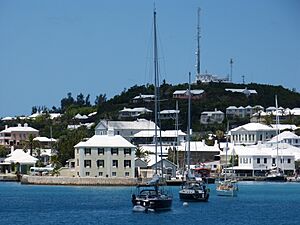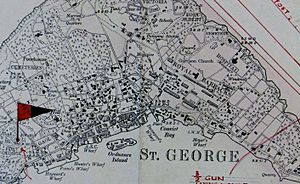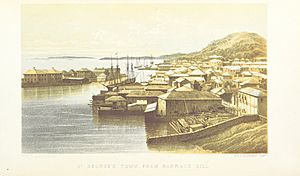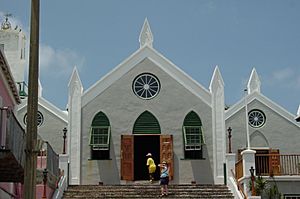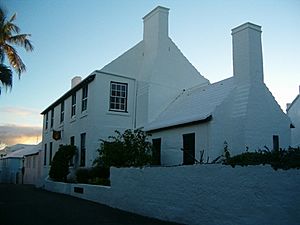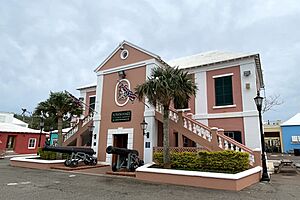St. George's, Bermuda facts for kids
Quick facts for kids
St. George's
|
||
|---|---|---|
|
Town
|
||
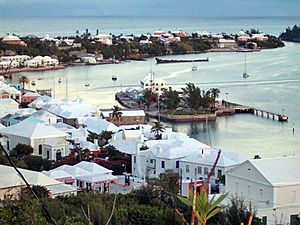
St. George's harbour and town, seen from Fort George
|
||
|
||

Location in Bermuda
|
||
| Country | ||
| Overseas territory | ||
| Settled | 1612 | |
| Population
(2016)
|
||
| • Total | 1,527 | |
| Climate | Af | |
| Official name: Historic Town of St. George and Related Fortifications, Bermuda | ||
| Type: | Cultural | |
| Criteria: | iv | |
| Designated: | 2000 (24th session) | |
| Reference #: | 983 | |
| Region: | Western Europe (and North Atlantic) | |
St. George's, also known as the Town of St. George, is a historic town in Bermuda. It is located on St. George's Island and next to St. George's Harbour. The town was settled in 1612. It was the first permanent English settlement on the islands of Bermuda.
St. George's is often called the third permanent British settlement in the Americas. It came after Jamestown, Virginia (1607) and Cupids, Newfoundland (1610). It is also the oldest continuously inhabited British town in the New World. This is because the other two settlements were only used for parts of the year for some time.
Contents
What's in a Name?
In Bermuda, when a place is named after a person, it often uses the possessive form. This means adding an "s" or "es" with an apostrophe. For example, St. David's Island and Cooper's Island are named this way.
St. George's is named after a person, so it uses the possessive form. Even when shortened, Bermudians usually keep the "s". For example, they say "St. George's Parish" instead of "St. George Parish". Maps made outside Bermuda sometimes miss this detail.
A Look Back in Time
St. George's was first called New London. It was settled in 1612. This happened three years after the first English settlers arrived on St. George's Island. They were on their way to Virginia.
The Shipwreck that Started It All
In 1609, a group led by Admiral Sir George Somers and Sir Thomas Gates was sailing to Virginia. Their ship, the Sea Venture, was caught in a big storm. To save everyone, they purposely steered the ship onto a reef near Bermuda.
The people who survived built two new ships, the Deliverance and Patience. Most of them continued their journey to Jamestown. However, the Virginia Company claimed Bermuda for England.
Early Settlers Arrive
Two men stayed behind to keep the company's claim on the islands. Later that year, a third person stayed when the Patience returned. In 1612, the Virginia Company sent 60 new settlers to Bermuda. They joined the three men already there.
After a short time on nearby St. David's Island, the settlers began building in St. George's. This spot was chosen because its sheltered harbour protected ships from bad weather.
Bermuda's First Capital
In 1615, the Virginia Company's shareholders created a new company called the Somers Isles Company. This company managed Bermuda separately. St. George's was the capital of Bermuda until 1815.
The town played a role in the history of colonial America. Many Bermudians moved to Virginia and other parts of the American Southeast. This happened before the United States became independent.
St. George's and American History
As Bermuda's main town and only real port, St. George's was connected to the American colonies. During the American War of Independence, Bermudians helped the American rebels. They stole much-needed gunpowder from a storage building in St. George's.
The powder was taken over a hill to Tobacco Bay. From there, boats carried it to an American ship waiting offshore. This helped the American rebels in their fight.
During the American Civil War, some British people from St. George's helped the Confederates. They did this by sneaking supplies and weapons past coastal blockades. This trade was centered in St. George's.
Exploring Historic Sites
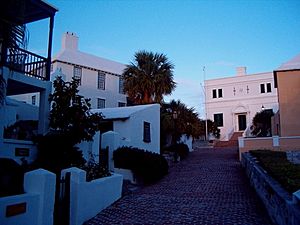
King's Square is the center of St. George's. Here, you can often see re-enactments of 17th-century life. The Bermuda National Trust Museum is also located on the square.
Ordnance Island is in St. George's Harbour, south of King's Square. It has a copy of the Deliverance ship. There is also a life-sized statue of Admiral Sir George Somers.
The town has many old historical places. These include the old State House from 1620. This was the first stone building in Bermuda (besides forts). It was built for the Parliament and is the oldest building on the island.
Other important sites are the Unfinished Church, the Old Rectory, and St. Peter's. St. Peter's is the oldest continuously used Protestant church in the Western world. You can also visit the Tucker House, the Bermuda National Trust Museum, and the St. George's Historical Society Museum. The Featherbed Alley Printshop museum is also a fun place to see.
In 1996, St. George's became a twin town with Lyme Regis in England. This is where Admiral Sir George Somers was born. In 2000, St. George's and its many forts became a UNESCO World Heritage Site. This means it is a very important historical place.
Sports in St. George's
The local football (soccer) clubs, St. George's Colts and Hamilton Parish, play their games at the Wellington Oval. This field is also used for cricket matches.
Learning in St. George's
St. George's has a preschool for young children. There is also a primary school called St. George's Primary School for older kids.
Famous People from St. George's
- Charles Delucena Meigs (1792–1869), an American doctor who specialized in childbirth.
- Robert John Simmons, who served in the Bermuda military. He later fought in the American Civil War for the Union army.
- Thomas Tudor Tucker (1745–1828), a doctor and politician from South Carolina.
- John Hamilton Gray (1814–1889), a Canadian politician and judge. He was one of the "Fathers of Confederation" in Canada.
- Reverend Robert Ashington Bullen (1850–1912), an Anglican priest, geologist, and expert on snails and slugs.
Gallery
-
St. George's Harbour, around 1864. Ships used by the Confederates are visible.
-
Statue of George Somers
See Also
In Spanish: Saint George (Bermudas) para niños



